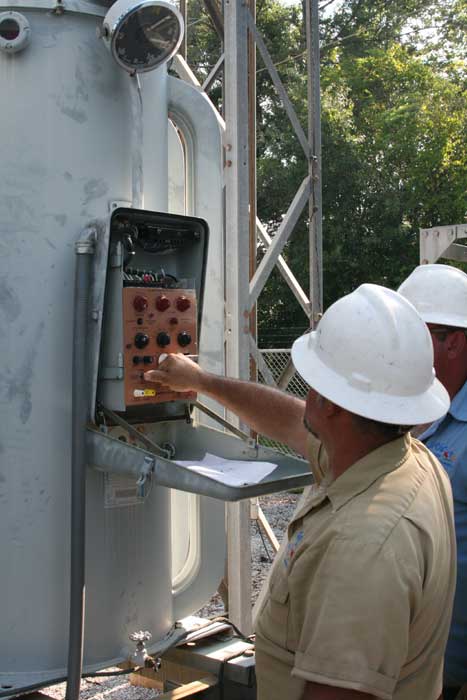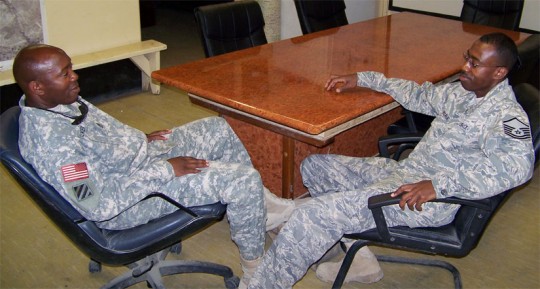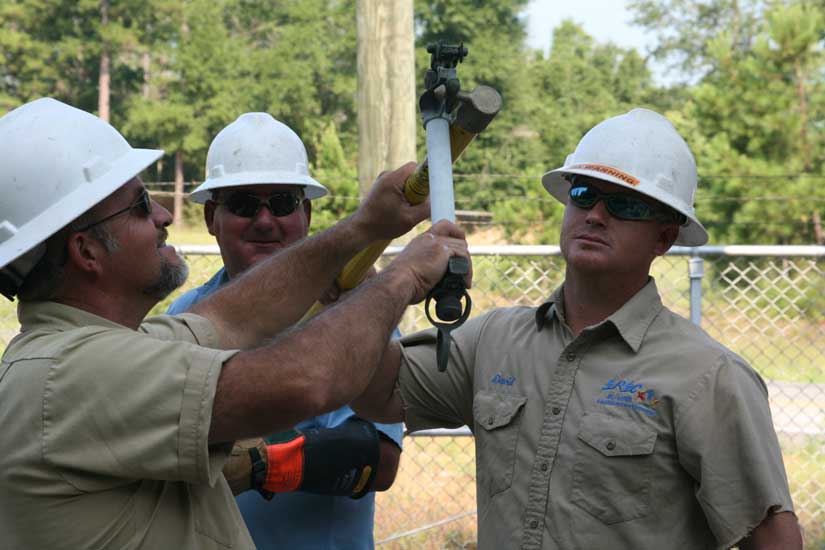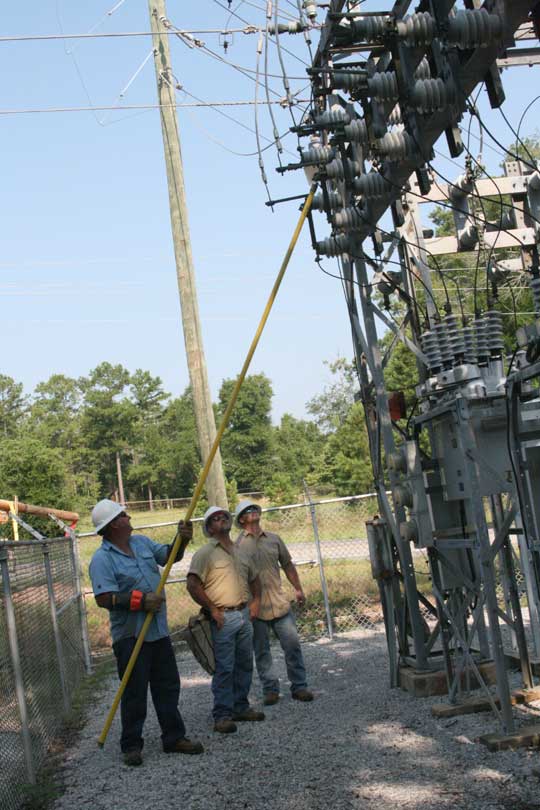Angel Food Donates 80,000 Pounds Of Food
July 16, 2010

Two tractor trailers loaded with food rolled up to the Gateway Church of Christ in Pensacola on Thursday morning for distribution to volunteers from 55 local organizations — including several in North Escambia — to help put it into the hands of those in need for free.
About 80 thousand pounds was delivered Thursday to a distribution site in Pensacola to assist families and workers impacted by the loss of work and business due to the Gulf oil disaster.
The food was from Angel Food Ministries, an organization dedicated to providing affordable, high-quality food to those in need.
“We have many oil workers who have come here to take care of the oil that washes up here; meanwhile no one is allowed in the water to fish or otherwise, and we have lost so much due to lack of tourism and commerce,” said Pat Senkow, Angel Food Outreach minister for the region. “In Escambia county we have 1,200 homeless children, and Santa Rosa County has 4,700 known homeless before the oil spoiled what we did have.”
North Escambia area organizations that participate in Angel Food Ministries include: Allen Memorial United Methodist Church, Pine Forest Assembly of God, New Life Baptist Church of Century, and the Poarch Band of Creek Indians. For more information about participating in the Angel Food program, call 1-888-819-3745 or visit www.angelfoodministries.com to find the nearest host site.
Local Brothers Find Themselves Deployed To Same Base In Afghanistan
July 16, 2010
BAGRAM AIRFIELD, Afghanistan – Two brothers from Atmore have been been deployed to the same base in Afghanistan.
Many armed services personnel are separated from their families for a long period of time on a regular basis due to deployments. Although some military members have a spouse or other family member that is also in the military and deploys frequently, rarely are they deployed at the same time or to the same location.
In Afghanistan, two brothers have found themselves deployed, not only at the same time, but to the same location as well. U.S. Army Sgt. 1st Class Dempsey Walker, supply support activity platoon sergeant, Company A, Task Force Workhorse, 3rd Combat Aviation Brigade, Task Force Falcon, from Atmore, Ala., has spent 24 years in the Army and is currently on his fourth deployment. His brother, U.S. Air Force Master Sgt. Nicholas Walker, a computer systems manager with the Combined Joint Special Operations Task Force – Afghanistan, also from Atmore, has spent 17 years in the Air Force and is currently on his third deployment. Both are deployed to Bagram Airfield, Afghanistan.
“This is the first time we have been deployed to the same base,” said Dempsey. “We were stationed in Korea at the same time and deployed to Iraq at the same time, but to different bases.”
“When I got here, my brother had already been here for six months,” said Nicholas. “It makes life here a lot easier, having a family member so close who can relate to what you are doing.”
Dempsey said he was anxious to join the military and chose the Army because it was able to let him join three months earlier than the other services. Nicholas, however, was not as anxious and made his decision based on the experiences of his brothers.
“We have an older brother that used to be in the Air Force,” said Nicholas. “After I talked to both my brothers, I decided the Air Force was right for me.”
According to Dempsey, the brothers get together at least once a week. They spend their time talking, going to church or just hanging out together. They usually eat at least one meal together whenever their schedules allow.
“It is nice to have a family member here to talk to,” said Dempsey. “Someone who is in the same location and situation and who can understand and relate to the types of problems that can pop up from time to time. In times like these, it is good to have your brother by your side.”
Pictured: U.S. Air Force Master Sgt. Nicholas Walker (right), a computer systems manager with the Combined Joint Special Operations Task Force – Afghanistan, sites and talks with his brother U.S. Air Force Master Sgt. Nicholas Walker (left), a computer systems manager with the Combined Joint Special Operations Task Force – Afghanistan recently at Bagram Airfield, Afghanistan. Photo by U.S. Army Sft. Robert Healy, Task Force Workhorse, 3rd Combat Aviation Brigade, for NorthEscambia.com, click to enlarge.
Ever Wonder What Happens When Your Power Goes Out?
July 15, 2010
Power outages were reported across the North Escambia area Wednesday night as a line of storms moved through the area. But have you ever thought about what happens when your power goes out? NorthEscambia.com thought we would take a look at the behind the scenes things that take place to get your power back on.
Our scenario below involves Escambia River Electric Cooperative and a hypothetical power outage in Walnut Hill. The events could just as well happen in any community in the North Escambia area on EREC, Gulf Power, Alabama Power, or Southern Pine Electric Cooperative.
Here’s our little story, “When the Lights Go Out”:
You were on your couch watching the TV early last night. The main storm has passed, and the rain outside has just about lulled you into a quick early evening nap.
Then it happens. Your power blinks one, two, three times and it’s off. You make your way in the dark to the kitchen where your glow-in-the-dark EREC magnet on the refrigerator is illuminated enough so that you can read the outage number. You call the number, 1-877-OUT-EREC, and follow the voice prompts to report your home’s outage. Your job is done.
What happens now? First of all, let’s set up the scenario for our hypothetical outage. Let’s say you live on Arthur Brown Road in Walnut Hill. This address receives power from the Oak Grove substation, just across the road from the Oak Grove Park on North Highway 99. You are assuming the evening’s thunderstorm is the culprit for your home being left in the dark. You know the proper action for you to take is to call the EREC outage number which you have done. Now, here’s the sequence of events which will take place to restore your power as quickly and safely as possible.
In our power outage scenario, your call comes in to the dispatch center and your name and address appear immediately on the computer screen. The dispatcher then contacts the on-call EREC crew to make repairs. Since the two-man crew is on-call for the evening, each crewman has driven home an EREC truck loaded with equipment and supplies necessary to repair any typical outage that might occur. So when the dispatch call is received, each crewman leaves his home and heads directly to the site of the outage. He does not need to take extra time to go by the EREC facility and get the vehicle, equipment and supplies needed to repair the outage.
 Upon arrival to the outage location, the crew investigates the reason for the power failure. Meanwhile they have received additional calls from the dispatch center letting them know there are other nearby houses on Arthur Brown Road, Corley Road and Juniper Street that are experiencing outages as well. After assessment of the power system, the crew determines that the cause of the outage is an RE failure (an oil reclosure breaker) in the substation due to a lightning strike.
Upon arrival to the outage location, the crew investigates the reason for the power failure. Meanwhile they have received additional calls from the dispatch center letting them know there are other nearby houses on Arthur Brown Road, Corley Road and Juniper Street that are experiencing outages as well. After assessment of the power system, the crew determines that the cause of the outage is an RE failure (an oil reclosure breaker) in the substation due to a lightning strike.
This can be handled quickly by the two-man crew so there is no need for additional personnel to be called in for assistance. The crew repairs the damage and calls the dispatch center to let them know all power has been restored. The dispatch center then calls back each member that has reported a power outage to be sure they do have power.
For more photos from inside the Oak Grove Power substation, click here.
The purpose of this story is to create a picture of what is actually happening during a typical power restoration. This is only a possible scenario and, of course, there are many different reasons why your power can go out.
“Although we cannot imagine all the power outage scenarios that can happen, there is one thing we can be sure of. EREC will be there to restore your power as quickly as possible in the dead of night, in the middle of terrible storms or whatever the case may be – EREC crews will do what needs to be done to get the lights back on,” said Sabrina Owens, EREC’s marketing director.
She said that in the case of major outages such as those that occur with hurricanes or other severe weather, specific procedures are in place to restore power to the most people in the shortest amount of time. The following steps describe power restoration after a storm.
- Transmission towers and lines supply power to one or more transmission substations. These lines seldom fail, but they can be damaged by a hurricane or tornado. Tens of thousands of people could be served by one high-voltage transmission line, so if there is damage here it gets attention first.
- Escambia River EC has several local distribution substations, each serving thousands of members. When a major outage occurs, the local distribution substations are checked first. A problem here could be caused by failure in the transmission system supplying the substation. If the problem can be corrected at the substation level, power may be restored to a large number of people.
- Main distribution supply lines are checked next if the problem cannot be isolated at the substation. These supply lines carry electricity away from the substation to a group of members, such as a town or housing development. When power is restored at this stage, all members served by this supply line could see the lights come on, as long as there is no problem farther down the line.
- The final supply lines, called tap lines, carry power to the utility poles or underground transformers outside houses or other buildings. Line crews fix the remaining outages based on restoring service to the greatest number of members.
- Sometimes, damage will occur on the service line between your house and the transformer on the nearby pole. This can explain why you have no power when your neighbor does. EREC needs to know you have an outage in this type of situation so that a service crew can repair it.
Members themselves (not the cooperative) are responsible for damage to the service installation on the building. The member will need to have a licensed electrician make these repairs.
For more photos from inside the Oak Grove Power substation, click here.
Special thanks to Sabrina Owens at EREC for her assistance with this story from our files , and to the linemen that assisted with the photographs. It’s worth noting that the photographs were taken on a nice sunny morning rather than during a real power outage after a storm due to the dangers of standing in a power substation after a storm has just passed.
Pictured above: EREC prepare to fix an oil reclosure breaker (RE) failure inside the Oak Grove power substation. Pictured below: That breaker is installed on a transmission line headed to the Arthur Brown Road area of Walnut Hill. NorthEscambia.com file photos, click to enlarge.
Thousands Attend Free Jimmy Buffett Concert
July 12, 2010
Tens of thousands of people — including many from the North Escambia area — packed the beach in Gulf Shores, Alabama, Sunday night for a free Jimmy Buffett concert as thousands watched on national television.
 Organizers gave away 35,000 free tickets for the show, which was televised nationally on CMT. Buffet’s free concert was to demonstrate his support for the people, businesses and culture of the Gulf Coast following the BP oil spill.
Organizers gave away 35,000 free tickets for the show, which was televised nationally on CMT. Buffet’s free concert was to demonstrate his support for the people, businesses and culture of the Gulf Coast following the BP oil spill.
“It’s all BP’s fault,” Buffett sang as he changed the lyrics in his “Margaritaville”.
Do you have photos from the concert? Submit them to news@northescambia.com
Pictured top and below: Jimmy Buffett performs Sunday evening in Gulf Shores, Ala. Photos courtesy CMT. Pictured inset : Northview High School student Lauren Cloud and Trent Sweeney from Jay at Sunday’s Jimmy Buffett concert. Pictured bottom of the page: The crowds arriving for Sunday’s concert. Submitted photos by Lauren Cloud for NorthEscambia.com, click to enlarge.
Count Shows Blue Angels Crowd Up (With Blues Photo Gallery)
July 11, 2010
It appears that attendance at Saturday’s Blue Angels Pensacola Beach Air Show was higher than last year, at least according to a Santa Rosa Island Authority vehicle count.
 A vehicle count from midnight Friday until 1 p.m. Saturday showed 9,431 vehicles passing through the toll booths to the islands, up from 8,579 last year. The Santa Rosa Island Authority estimates that an average of three people were in each vehicle, meaning 28,293 traveling to the island. Those numbers do not include people already on the beach or those traveling from Navarre.
A vehicle count from midnight Friday until 1 p.m. Saturday showed 9,431 vehicles passing through the toll booths to the islands, up from 8,579 last year. The Santa Rosa Island Authority estimates that an average of three people were in each vehicle, meaning 28,293 traveling to the island. Those numbers do not include people already on the beach or those traveling from Navarre.
For a Pensacola Beach Blue Angels photo gallery, click here.
Photos courtesy Cheryl Casey Photography
Ray’s Chapel Youth Visit Planetarium
July 11, 2010
The youth and children from Ray’s Chapel Baptist Church enjoyed a Saturday trip to the Pensacola Christian College Planetarium as they prepare to kick off their Vacation Bible School this week.
The group enjoyed the 36-minute “The Heaven’s Declare” show, exploring the sun, planets, constellations and galaxies of the universe on the planetarium’s 50 foot dome.
 The Ray’s Chapel Baptist Church VBS “Operation Space” will be July 12-16 from 5:30 until 8:00 each night for ages 5-12.
The Ray’s Chapel Baptist Church VBS “Operation Space” will be July 12-16 from 5:30 until 8:00 each night for ages 5-12.
“We are going to have skits every night featuring Capt. Scott, Turbo the robot and the crew of the Spaceship Intrepid. There will also be crafts, games, great food and bible briefings conducted by our special flight crew for the week,” according to Ray’s Chapel member Heather Leonard.
For photos from the Ray’s Chapel Baptist Church visit to the PCC Planetarium, click here.
Pictured: The youth and children from Ray’s Chapel Baptist Church visited the Pensacola Christian College Planetarium Saturday. Submitted photos by Heather Leonard for NorthEscambia.com, click to enlarge.
Do you have church news you would like to share? Email news@northescambia.com
Featured Recipe: Sweet And Savory CalRio Cuban Pie
July 11, 2010
This weekend’s featured recipe from Janet Tharpe is a CalRio Cuban Pie. Pulled pork, deli ham, Roma tomatoes, Swiss cheese are more combine to create this flavorful ethnic dish.
To print today’s “Just a Pinch” recipe column, you can click the image below to load a printable pdf with a recipe card.
Shelly Womack Named Escambia County Junior Miss
July 11, 2010
Shelly Womack was named Escambia County (Ala.) Junior Miss Saturday night at Jefferson Davis Community College in Brewton. Womack, the daughter of David and Janet Womack, is a student at Excel High School.
First alternate was Cierra White of Flomaton. She is the daughter of Earnie White of Flomaton and the late Angie White. She is a student at the Alabama School of Math and Science.
Walton Nichols of Atmore was named second alternate. She is the daughter of Randy and Melissa Nichols of Atmore.
Six young ladies took part in the program Saturday night. They were: Megan Andrews, Dallas Brown, Walton Nichols, Kelsey Templeton, Cierra White and Shelly Womack.
Pictured: Shelly Womack (center) was named Escambia County Junior Miss Saturday. Cierra White (left) was named first alternate, and Walton Nichols (right) was named first alternate. NorthEscambia.com graphic, click to enlarge.
July Lawn And Garden Tips
July 10, 2010
 Timing is the key to success in your lawn and garden. And in this weekly feature, Teresa Friday, the Residential Horticulture Extension Agent for Santa Rosa County, offers an assortment of July lawn and garden tips.
Timing is the key to success in your lawn and garden. And in this weekly feature, Teresa Friday, the Residential Horticulture Extension Agent for Santa Rosa County, offers an assortment of July lawn and garden tips.
Flowers
- Plant heat-tolerant annuals such as: celosia, coleus, crossandra, impatiens, kalanchoe, nicotiana, ornamental pepper, portulaca, salvia, and vinca.
- Lightly re-fertilize to enhance color and vigor.
- Deadhead, or pinch off, spent flowers to stimulate more flowering.
- Pinch back leggy growth.
- Check roses for black spot fungus and apply a fungicide if necessary.
- Mulch beds to 3-inches deep to help control weeds.
- Monitor weekly for insect or disease problems.
- Increase air circulation between plants. This helps prevent formation of fungal diseases such as leaf and stem blights.
Trees and Shrubs
- Crape myrtles are blooming, so it’s an excellent time to select them for your landscape. Choose cultivars with the appropriate mature size for your site.
- Deadhead crape myrtles to extend bloom time.
- Check azaleas for the large, black azalea defoliator caterpillars. Control by hand picking or use an approved insecticide.
- Watch for spider mites on shrubs and flowers; lacebugs on azaleas and pyracantha; flower thrips on roses, gardenias and other blooming plants; and oleander caterpillars on oleanders.
- Prune hydrangeas and gardenias when flowering stops.
- Do not heavily prune any of the spring flowering shrubs such as azaleas, camellias or spiraea.
- Give trees a pre-hurricane check. Look for limbs that might snap and trunks that could split. Prune immediately.
- Psocids (tree cattle) create the white webbing covering the branches and trunks of some trees. They feed on surface debris and do not injury the trees.
Fruits and Nuts
- Prune blueberry bushes after harvest is completed.
Vegetable Garden
- Plant eggplant, lima beans, okra, southern peas, peppers and watermelon.
- Remove spring-planted tomato plants from the garden once harvesting is complete.
- Burn or remove diseased plants from your property. Don’t place them in the compost pile.
- Set out new tomato plants by late July. Try the “hot set” varieties.
- Control tomato hornworm and fruitworms.
- Establish a compost pile; high temperatures and frequent showers speed the breakdown process.
- Solarize the soil to reduce nematode population in the vegetable garden. Remove old plant debris, till the area thoroughly, moisten well and cover with clear plastic film. Seal the edges with soil. Leave the cover on for 6 weeks.
Lawns
- Monitor for sod webworms, spittlebugs, chinch bugs, caterpillars and mole crickets.
- Use a soap drench to irritate insect pests into moving, making them easier to see. Mix 1 ½ oz of liquid dishwashing soap and 2 gal of water in a sprinkling can, then equally distribute the solution in over a 2 X 2 foot area.
- To reduce stress on the lawn: mow before it is too high, keep mower blades sharp and raise the mowing height by ½ inch when the weather is hot.
Contact your local Extension Office for detailed instructions on these recommendations.
Century Resident Completes 500 Mile Hike Across Spain (With Photo Gallery)
July 7, 2010
Over the past month, we have followed the journals of Century resident Terri Sanders as she hikes 500 miles across Spain this summer.
As Terri hiked from Saint-Jean-Pied-de-Port, France, she filed dispatches from her journal and sent pictures when possible for NorthEscambia.com as she hiked the Camino de Santiago — the Way of St. James — to the Atlantic Ocean.
To read the complete series from day one, click here. For a photo gallery from her trip, click here.
Today, we bring you Terri’s final journal entry as she finishes her pilgrimage on the Camino de Santiago.
June 30, 2010
Start: Arca
Destination: Santiago De Compostela
 It was just before 6:00 a.m. when someone snagged the chair at the head of my bunk with their leg and went sprawling. Needless to say I was awake then. I even beat John out of bed. Throughout the morning all I wanted to do was walk slow and drink in every detail of this last day of the Camino. The path was lined with the ever present stands of eucalyptus trees and the shade they provided was very welcome. Then as we grew closer to the city the woodsy path was replaced by asphalt and more and more people crowded the trail.
It was just before 6:00 a.m. when someone snagged the chair at the head of my bunk with their leg and went sprawling. Needless to say I was awake then. I even beat John out of bed. Throughout the morning all I wanted to do was walk slow and drink in every detail of this last day of the Camino. The path was lined with the ever present stands of eucalyptus trees and the shade they provided was very welcome. Then as we grew closer to the city the woodsy path was replaced by asphalt and more and more people crowded the trail.
It was 10:45 am when we crossed into the city limits of Santiago. We came down an incline and could see the city spread out before us. We had done it! We had hiked 800 kilometers across Spain! It took us another hour to get through the city to the cathedral square where we stood in line for another 45 minutes to turn in our credentials and get our compostela, our certificate of completion.
We had planned to say in Cathedral Square in the oldest hostel in the world that is in constant use. We thought it would be a nice ending for our walk. We had planned on it being higher than our usual alburque but the price of 275 Euros a night changed our mind. We were approached by a lady on the street offering pilgrims places to stay for a reasonable price.
At first we were a bit concerned but when we saw the room we were grateful. It is one room with three twin beds, a common shower and bath. It cost us 15 Euros each and we are virtually in the middle of cathedral square. We found a quaint cafe with great food and had lunch, then walked around the square taking pictures acting like common tourists. There was a group of camera men taking pictures and interviewing some guy who must have been important and we were right in the middle of all of it. He kept walking and talking, the cameras kept rolling and we stayed in back of the group the whole time. Someone later said it was some famous rock singer.
There are several quotes from our guide book that I would like to quote here. One of the most potent aspects of the pilgrimage is the extended time it requires away from the familiar. This allows an opportunity for the inner alchemy of spirit to start its work of transformation. It is not just the physical body that needs to sweat off the excess baggage, the mind needs purifying also. Our world is a mess and we are not going to fix it with more of the same. We need a fresh approach and a different mindset to the one that created the chaos in the first place. Hopefully this re-ordering of the way we see the world will quicken apace as we open to lessons presented to us along the Camino and begin to understand that life itself is a classroom.
A purpose of pilgrimage is to allow time for old belief systems and outworn truths to fall away so new and higher perspectives can arise. Collectively we live in a spiritual vacuum of our own making where the mystical and sacred have been relegated to the delusional or escapist. Accordingly we live in a three dimensional world and refuse to open the door to higher dimensions of reality. We have impoverished ourselves in the process, severely limiting our potential. We are terrorized by the chaotic world we have manifested around us and we have become ensnared in its dark forms. We have become so preoccupied with these fearful images we fail to notice that we hold the key to the door of our self made prison. We can walk out any time we choose!
It was months before I realized the changes that hiking the AT had made in me. Still today there are times that another change is brought to mind. I suppose it will be the same with my Camino hike. The only noticeable difference I have seen is the fact that about halfway through this hike I began to write poetry. I have always written but never poetry. It is like these poems were inside me all the time just waiting for me to open a door to let them out. The problem was I didn’t know that door even existed much less needed to be opened. Tomorrow we become tourists for a few days before we journey back to the states.
Miles 12.8
The End.












